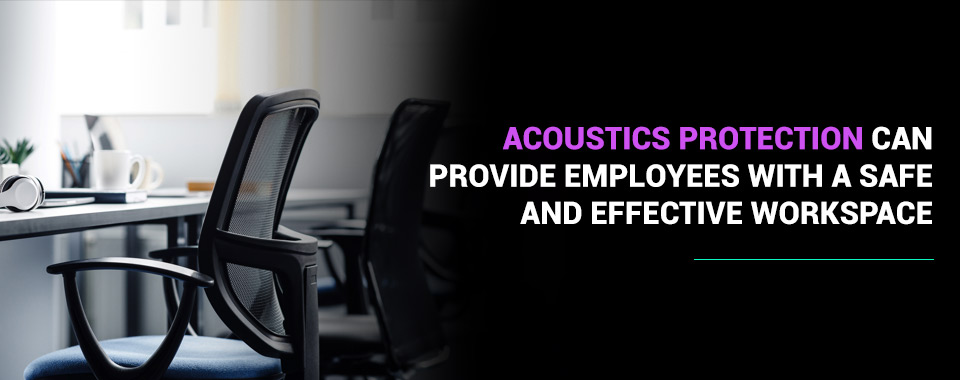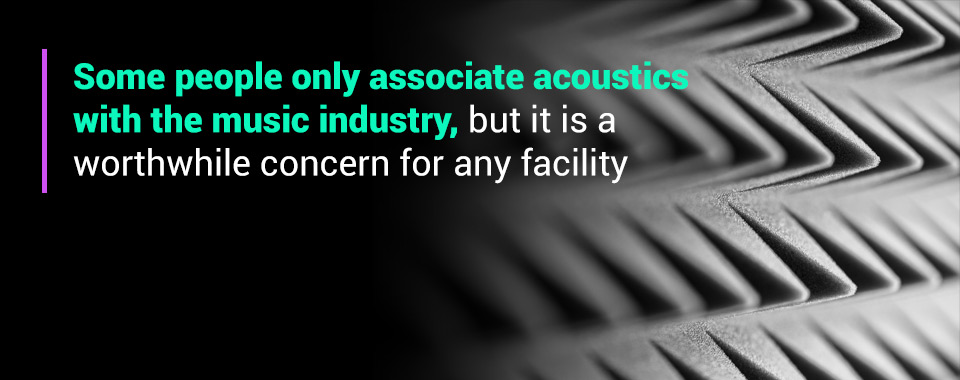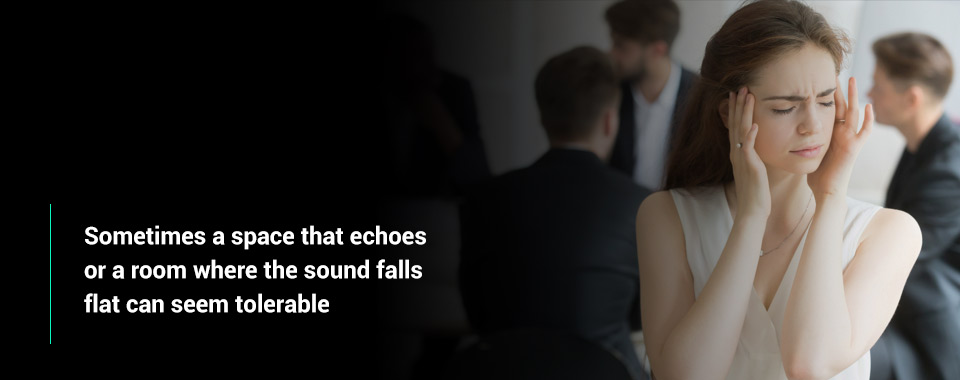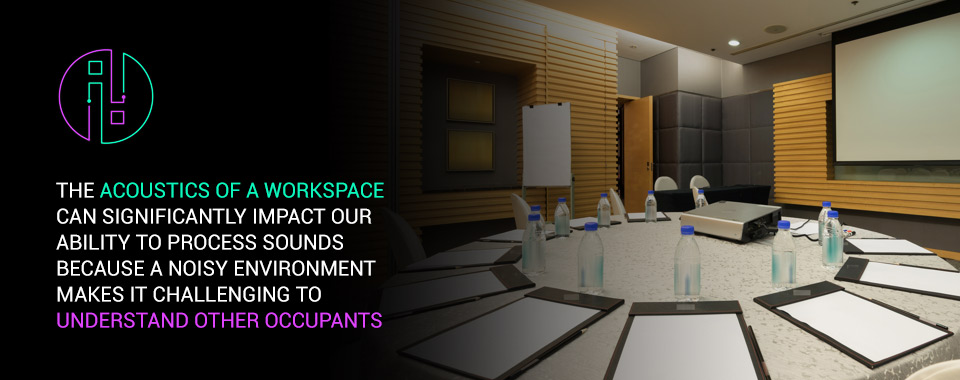

High noise levels in the workspace are a significant concern for workers and clients alike. Many businesses experience a rapid increase in noise pollution, which can be dangerous to a person’s health and productivity. Many locations and building types benefit from proper acoustic protection, including school auditoriums, hotels, restaurants, theaters, performance and sports venues, nightclubs, casinos, corporate buildings, warehouses and places of worship.
With several factors contributing to the rise in noise pollution, the importance of acoustic protection and quality sound design in our daily lives has never been more prevalent.

Acoustics protection can provide employees with a safe and effective workspace by fostering a more comfortable soundscape. Rather than trying to enforce a silent work environment, acoustic protection helps manage the noise levels and reduce any background noise.
Some people only associate acoustics with the music industry, but it is a worthwhile concern for any facility. Acoustics describe how sound waves interact with the environment. Aspects such as reflection, reverberation and resonance make acoustics a determining factor of how pleasant or unpleasant a space sounds. The concept of acoustic protection comes from the fact that most buildings require some help to maintain safe and productive noise levels. Appropriate sound design will protect workers against harmful, loud sounds by achieving better acoustics.
For some building types, such as warehouses and theaters, bad acoustics can be detrimental to a worker’s performance or client’s experience. Sometimes a space that echoes or a room where the sound falls flat can seem tolerable. However, good acoustics will bring valuable benefits to any business location or building.
Here are five acoustic protection benefits that apply to numerous facilities:
The acoustics of a workspace can significantly impact our ability to process sounds because a noisy environment makes it challenging to understand other occupants. As the listener, you may need to concentrate more, which will quickly drain your energy. Meanwhile, the person speaking may need to talk louder, which only adds to the room’s noise level. Too much background sound makes effective communication increasingly difficult.
Whether it’s a school lecture hall or an open-plan office, proper acoustic protection will improve your ability to hear and understand each other. You can modify a building’s structures and furnishings to absorb unwanted noise, such as echoes. Diffuse surrounding sounds to enhance the concentration of everyone inside the building. Appropriate acoustic protection reduces the background noise, ensuring the sounds you want to hear are clear and audible.

Acoustic protection can help keep the audience focused on a theatrical show. Meanwhile, good acoustics can benefit a classroom or office space by maximizing performance. Spectators, students and workers alike can better understand the surrounding conversation with the right acoustic protection measures.
Noise pollution makes work more challenging. Depending on the activity you’re engaging in, a loud sound can easily divert your focus and diminish productivity. Still, it’s essential to keep some sounds in these settings. Since a silent workplace can be just as distracting as a noisy one, proper acoustic protection will only minimize and cancel the unwanted noises that will break concentration.
When outside sounds are kept out and minor disruptions are absorbed, people can stay on task and achieve more in a given amount of time. Whether they’re enjoying a musical performance, taking notes in class or completing work in their cubicle, people will be able to remain focused without background distractions getting in the way.
High noise levels can impair our ability to work and learn, causing people in noisy environments to feel more irritable, unnerved and stressed. You may even feel pain from too much sound hitting your ears during an eight-hour workday. If your senses regularly process a large number of loud sounds, your energy will deplete even quicker — this impact on your energy levels can increase the risk of workplace accidents.
Workers must be able to hear one another, especially in workspaces with loud machinery or equipment. Loud outside sounds make it more challenging to stay on task and often prevent you from hearing alerts or warnings. As a result, reducing noise levels will create a safer and more welcoming environment for employees and clients.
By absorbing echoes, reducing background sounds and limiting other noises, acoustic protection can make it easier for people to hear one another in any environment. Avoiding accidents is much more manageable when people can focus and communicate efficiently.
Today, many workspaces and buildings have glass windows, hardwood, tile, concrete, bare walls, and other hard surfaces that effectively bounce sound off themselves in another direction. Unwanted outside noises and reverberations from your equipment aren’t the only sounds that can carry in a room. Echoes can easily carry private conversations throughout spaces without proper acoustic protection.
Implement better noise absorption to muffle sound and prevent voices from carrying too far from their source. This increased privacy will allow people to hold conversations with the peace of mind that others cannot hear their words from across the room.

Because acoustic protection can help improve your staff’s concentration, team members can retain their focus without needing to repeat themselves constantly. They’ll work more efficiently, ensuring the products are further protected from workplace accidents.
Additionally, the right acoustics and acoustic protection can take a decent sound system and significantly improve its quality. Whether you’re managing a theater or a corporate space, you want to provide the best sound quality possible for a speaker addressing their audience. Appropriate acoustics protection will make your shows and presentations sound better.
High noise levels kill the nerve endings inside the inner ear. Short-term exposure to loud noises can lead to a humming in your ears or a temporary change in your hearing. Meanwhile, repeated exposure to loud noises could cause more damage, including permanent hearing loss. Improper acoustic protection will only increase your risk of noise-induced hearing loss together with the following factors:
Noise-induced hearing loss, or NIHL, can occur whenever you hear loud sounds. This noise can be continuous, like listening to a concert, or a thunderous burst of sound, like an equipment explosion. Proper acoustic protection is intended to reduce your risk of hearing loss, but these high-performance solutions can only be effective when implemented correctly.
Without appropriate acoustic protection, loud sounds have nowhere to go and damage your inner ear. Repeated noise exposure can make you more tired, irritable and significantly impair your ability to communicate. You put the entire team at increased risk of injuries and accidents when you cannot hear and respond to warning signals.
In addition to permanent hearing loss, high noise levels can lead to other health problems, such as:

You may need to improve the acoustics in your workspace if you notice any of the following signs:
If your team members report any indication that noise is too loud in the workspace, it is vital to implement proper acoustic protection before more permanent damage occurs. The National Institute for Occupational Safety and Health (NIOSH) has created a tool that you can download on your mobile device to measure the sound levels in your building. The Sound Level Meter App provides helpful noise exposure parameters you can use to reduce the risk of noise-induced hearing loss.
According to the Centers for Disease Control (CDC), about 22 million employees experience exposure to high noise levels at work annually. That’s why the Occupational Safety and Health Administration (OSHA) has regulations surrounding noise exposure to protect workers from the potentially damaging effects of loud sounds.
Noise levels are measured in decibels or dBA. Any sound that registers at or below 70 dBA will not impact your health. When averaged over an eight-hour workday, sounds at 85 dBA or higher can lead to hearing loss. OSHA’s Noise Standard provides that employers must reduce noise exposure in the workspace and start a hearing conservation effort when the environment exposes employees to noises at or above 85 dBA for more than eight hours.
Use a sound-measuring instrument, such as the Sound Level Meter App, to ensure the noise levels in your workspace are safe for employees. Noise dosimeters and octave band analyzers can also help you measure the noise levels in any building type. Appropriate acoustic protection can decrease occupational noise-induced hearing loss if noise is too loud. Beyond keeping your team safe, acoustic protection benefits your workplace by keeping you compliant with relevant standards.
Choose from various acoustic treatments and high-performance solutions to improve your workspace’s noise levels. At Illuminated Integration, we provide the following acoustics services to help with the acoustic protection of any facility:
These acoustics services offer many unique solutions to address reflection, reverberation and resonance. Many building types need a combination of solutions to achieve the best acoustics.
When installing sound absorption products, it is important to know which materials will best absorb the acoustics in your facility. Particular surfaces will absorb sound waves, while most hard surfaces will cause sounds to bounce off and travel around the room.
Sound-absorbing materials, often categorized as sound absorbers or sound diffusers, can absorb echoes due to their soft, fluffy, light or porous nature. Depending on the frequency of the sound waves you need to mitigate, you may choose one of the three primary materials:
When you want to improve a room’s acoustics, sound absorption is a necessary solution that can take on a nearly infinite number of combinations. The right sound-absorbing material will reduce echoes and other unwanted background noise so that all you’ll hear are the clear and audible sounds within the space.

Since several acoustic treatment options are available on the market, it may seem challenging to determine the correct solutions for your space. Common acoustic protection examples include:
On your own, deciding what combination will result in the best acoustic quality can take some trial and error until you find the right balance. At Illuminated Integration, we understand that there is no one-size-fits-all solution to your acoustics. After our team diagnoses the sound problems in your facility, we’ll offer a perfectly tailored solution. Our acoustic protection proposal will be designed specifically for your space and how you want the acoustics to sound.
You’ll notice a genuine difference in the environment once you’ve achieved the ideal acoustics. Whether it’s an office, hotel, theater, school, store, restaurant or any other type of building, all occupants in your facility will benefit from the comfort and safety that proper acoustics protection can provide.
Improper acoustics protection can be dangerous for any facility. Without appropriate acoustics protection, the occupants of a space will have nothing to absorb, block or cover the loud noises in the environment. This exposure has countless effects, but there’s a solution — designed and tailored just for your facility. When working in a theater, school, office or any other building, acoustic protection can have a positive impact on any environment and the people working in it.
Illuminated Integration offers various acoustics services, from direct audio coverage, audio analysis and modeling to material selection for ideal sound absorption and diffusion. No matter the size or complexity of your building, we will meet the needs of any project. Our capabilities can even extend from sound design to cover your lighting and video needs, too. As an audio, video and lighting (AVL) company, we can handle it all with high-performance solutions.
Contact Illuminated Integration for more information about acoustic protection and how your facility can improve its acoustics today.